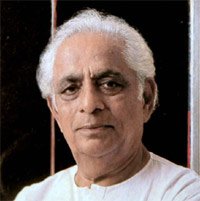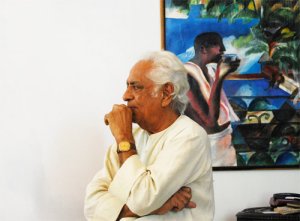 |
  |
 |
  |
Dashrath Patel 'In the Realm of the Visual' - Dr. Sunil Kothari e-mail: sunilkothari1933@gmail.com December 30, 2010  It is with a heavy heart that I write this obituary. Dashrath Patel was a dear friend. He was a soul mate of the celebrated dancer Chandralekha. I met him in 1956 when I attended for the first time, a Bharatanatyam performance of Chandra in Mumbai at Rang Bhavan. He was assisting her backstage, before the performance. I had known of him as a painter and seen his early paintings when he was studying under painter Rasiklal Parikh in Ahmedabad. I had also seen him once at Bhulabhai Memorial Institute at Mumbai where Gaitonde, Ambalal, Tyab Mehta, Hussain and other painters were using the studio at a rent of rupee one per day! Bhulabhai Memorial Institute was the hub of painters, musicians, dancers, photographers and artists. Soli Batliwala, the trustee, looked after all of them. Madhuriben, widow of Bhulabhai Desai, was a gracious host and welcomed artists with warmth and affection. We all were indulged by Solimama as he was known. He was fond of Chandra and Dashrath. I remember Solimama once told me that Dashrath had returned from Paris after a very successful exhibition and Picasso had gone to see his show and admired Dashrath's work. Very few know this. In Gujarati monthly Kumar published from Ahmedabad, I had seen water colours of Dashrath's mentor Rasiklal Parikh. Chandra also introduced me to poet Harindranath Chattopadhyaya, whom she and Dashrath addressed as 'Baba'. I came to know them well as Chandra, Dashrath and Harindranath stayed together in Chennai when Dashrath was studying painting at the Government College of Fine Arts in Chennai from 1949 till 1953 under Deviprasad Roy Chowdhry. His son was Bhaskar Roy Chowdhry, who also performed Bharatanatyam. Chandra was studying Bharatanatyam under Kanchipuram Elappa Pillai and often Harindranath used to read poems before Chandra's performances.  Dashrath received a fellowship to study abroad in France at Ecole de Baux Arts in Paris. During his first solo show of paintings, Cartier Bresson had come to see his exhibition. Cartier Bresson had asked Dashrath to take a photograph of his own painting. He argued with Cartier Bresson that he was not interested in photography. Cartier still asked him to take a photo of Dashrath's painting with his Leica camera. After a fortnight, Cartier Bresson came and asked Dashrath to see the prints he had made of the photo taken by Dashrath of his own painting. Dashrath was amazed at Cartier's insistence and started taking photographs. After that Dashrath never looked back. Cartier was his mentor and guide. Dashrath was vastly gifted and Gira and Gautam Sarabhai extended all the support to him for his creative endeavors. When National Institute of Design (NID) was conceived and founded in 1961, Dashrath's inputs were most valuable. He was one of the founders of NID. Though Dashrath never finished formal school education and hardly got any formal academic training in the arts, he was already known as an artist. He was a multi-faceted personality. He was a painter, a ceramist, a brilliant photographer and a designer. His guru as we have noticed above in photography was legendary French photographer Henri Cartier Bresson. Because of Chandra, I came to know him well. He was a very simple person. Born in Sojitra, Nadiad District in Gujarat in 1927 in a Patel family, he did not go into business as Patels do. He decided to be a painter. His parents relented and allowed him to do what he wished. Being an artist, he got rare opportunities to interact with designers like Charles Eames, and 'avant- guarde' musicians like John Cage, architects like Louise Kahn and Frie Otto and engraver William Hayter, to name a few luminaries. Henri Cartier Bresson, whenever he visited India and Ahmedabad, stayed with Dashrath. When he came in 1970 to Ahmedabad, I was staying with Chandra at Dashrath's residence in Ahmedabad. I met Cartier Bresson and I could see that he and Dashrath were 'great buddies.' Cartier was very fond of Chandra and has taken several photographs of hers. Dashrath, Chandra and Cartier admired each other's work. Dasharth joined NID as an instructor and was assigned to design several important exhibitions like one on Mahatma Gandhi, on Nehru, expos of Montreal, and Festivals of India in France and USSR. I was fortunate to be with Chandra and him, as they allowed me to be with them, as later on Sadanand Menon did. To be with Sadanand, Dashrath and Chandra was a continuous learning. Vastly gifted, this triumvirate has created history individually and collectively in the field of art, dance communication and journalism. Sadanand curated Dashrath's exhibition of paintings, graphics, photographs, ceramics, designs, and posters at the National Gallery of Modern Art (NGMA) in New Delhi which astounded artists from each discipline. A documentary film 'In the Realm of the Visual' made by Irfat, an alumni of Jamia Milia Islamia has captured Dashrath's art and life, his simplicity, in this extremely well made documentary in an engaging manner. It was screened on 29th December 2010 at the Spaces Art Centre that Dashrath had co-founded with Chandra, at 1, Elliot Beach Road at Besant Nagar in Chennai. Some of his friends came from various parts of India and some from abroad to pay tribute to him. Lalit Kala Akademi, Chennai branch also extended their support for that evening remembering Dashrath Patel. For the past ten years Dashrath was visiting Alibag near Mumbai where his admirer and friend, renowned architect Pinakin Patel invited him to live and work in a quiet peaceful environment. He built a museum for Dashrath's works which has been designed as a centre where creative artists can meet on weekends. Thirteen months ago, Dashrath moved there to live and continued drawing, painting and teaching painting and photography to school children at Alibag. I visited him last year and gave him a DVD of Balasaraswati, in which she has sung and danced to "Krishna ni begane baro," a poem of Purandaradasa in her melodious voice. Dashrath knew Bala well and had photographed her when I was editing a book on Bharatanatyam for Marg Publications. Because of Chandra and his life long association with her, Dashrath knew Elappa Pillai, who used to conduct nattuvangam for Bala. Chandra was a disciple of Elappa, therefore Elappa conducted nattuvangam for Chandra. She, Dashrath and Hrishikesh Mukherjee were intimate friends. Those excellent photos taken by Dashrath of Balasaraswati are at National Institute of Design (NID) as are other photos he took of Rukmini Devi, ace veena vidwan Balachander, Kuchipudi bhagavatara Raghavaiyya and a few dancers. Dashrath has designed my book Kuchipudi dance-drama published by Abhinav Publications. Bala was very fond of Chandra and Dashrath. Dashrath has also taken innumerable photos of Chandra's solo performances and also her choreographic works. Often he would sit at the farthest corner of an auditorium and without drawing attention of any one, he would shoot quietly. All those photos now form part of an archive of Chandra's works at Spaces. When he turned 82, Dashrath underwent an operation for a massive heart attack; he had gone frail and was leading a quiet life. He had spent thirteen months at Alibag and then had moved to Ahmedabad to his residence. But he never stopped drawing. Sadanand has written in his tribute to Dashrath in Frontline Magazine: 'On the morning of December 1, 2010, Dashrath Patel sat on his chair by the window in his home, gripped his thick-nib bamboo pen, dipped it first into the black inkpot and then into red, placed the tip on the open page of his note book and let the play of light guide his wrist. There was a surge of flowing lines. He had whipped up a whirlwind. He kept his bamboo pen aside and gently picked up the long, sturdy pea-hen feather I had found for him, a few days ago, in the campus of the Sarabhai Foundation in Ahmedabad. He had sliced the tip to a thin point and was using it as his quill. Once again he mixed the inks and let the feather give wings to his imagination. Three more pages of abstract forms flew out from within the infinite resource of fantasy he was blessed with. He could summon forms at will. A lifetime of filling pages and notebooks with a mind-boggling abundance of lines, and he still felt he was nowhere near to being satisfied. Literally hundreds of notebooks lovingly inscribed with this unceasing quest for form. When he was not doing anything else, Dashrath was drawing. His hands would quiver if he had to sign a cheque. But when he was drawing it was like a musician catching his sruti. The creator and his creation aligned on the same axis." I would like to sum up Dashrath's personality in the words of Sadanand Menon. "Dashrath was like one of those innocent wide-eyed heroes of post-Independence Indian cinema, bursting with idealism and faith in the capacity of the artist to transform society. Gifted with cornucopia of diverse skills and talents, he believed that nascent industry of young India would automatically be on the look-out for an indigenous Indian design. He aligned himself with 'national' design project without a second thought, as the National Design Institute was set up in 1961 and started its professional design practice and pedagogy in 1963. After two decades of training a generation of designers and design teachers and having interacted closely with Indian industry, Dashrath would be heard saying exasperatedly: 'The Indian industrial class lacks both dignity and courage. They are just sons of merchants, conservative to the core. Their sole interest is gathering profit without investing in the future of the industry in product, process or human development.' It is the kind of scathing critique of the industrial class I have never heard even Marxist critics make. Dashrath was mercurial in the present; and looking ahead. Whenever the 'nation' seemed to goof, he was there offering help, a handyman, a visual thinker, a man of his times. Suddenly, the dappled light seems profligate." Sadanand learnt and worked with Dashrath for 35 years. In 1998, he curated 'In the Realm of the Visual,' Dashrath's 50 years 'Retrospective Exhibition' in painting, ceramics, design and photography for the NGMA, Delhi. It was re-mounted in 1999 for NGMA, Mumbai. He is a versatile lights designer and a photographer. For Chandralekha's choreographic works from Angika to Sharira, Sadanand has done lighting. As an arts editor of The Economic Times for five years, he created a record in art journalism. Currently he is an adjunct professor at the Institute of Asian journalism in Chennai. Dashrath Patel Museum in Alibagh, off Mumbai, houses his collected works under one roof. Created with the help of designer friend Pinakin Patel, it is open on weekends. Recently, a book 'Why the sky is blue?' based on his photographs of Nobel laureate scientist CV Raman, when the later delivered a lecture at Ahmedabad at the invitation of his disciple Vikram Sarabhai, has been published with text by Chandralekha. I had attended that lecture when Dashrath was taking photographs. The catalogue by Sadanand Menon of Dashrath's exhibition is another valuable book along with Irfat's documentary. Dr. Sunil Kothari, is a dance historian, scholar, author, and a renowned dance critic. |